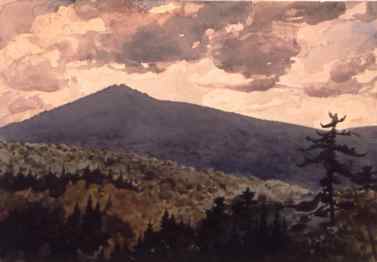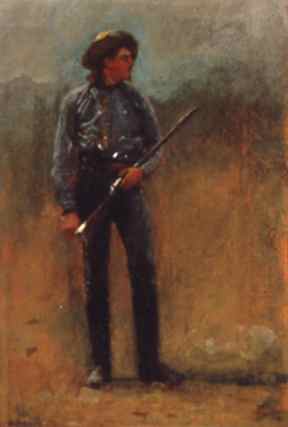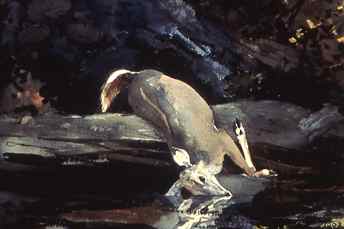
Editor's note: The Fenimore Art Museum provided source material to Resource Library Magazine for the following article or essay. If you have questions or comments regarding the source material, please contact the Fenimore Art Museum directly through either this phone number or web address:
Winslow Homer: Masterworks from the Adirondacks
June 21 - September 6, 2004

(above: Winslow Homer (1836-1910), Burnt Mountain, 1902, watercolor and graphite on paper. Addison Gallery of American Art, Phillips Academy, Andover, MA)
This summer, Cooperstown
is the place to see a unique exhibition of some of Winslow Homer's great
Adirondack paintings and watercolors. Winslow Homer: Masterworks from
the Adirondacks will be presented exclusively  through
September 6, 2004 at Fenimore Art Museum. This one-of-a-kind exhibit includes
fifteen of the artist's most powerful works in watercolor and oil, along
with twelve wood engravings from popular periodicals. Featured are loans
from the Metropolitan Museum of Art, Boston Museum of Fine Arts, Sterling
and Francine Clark Art Institute, and Philadelphia Museum of Art, among
others. (right: Winslow Homer (1836-1910), The Boatman, 1891,
The Brooklyn Museum. Photo by Graydon Wood, 1993)
through
September 6, 2004 at Fenimore Art Museum. This one-of-a-kind exhibit includes
fifteen of the artist's most powerful works in watercolor and oil, along
with twelve wood engravings from popular periodicals. Featured are loans
from the Metropolitan Museum of Art, Boston Museum of Fine Arts, Sterling
and Francine Clark Art Institute, and Philadelphia Museum of Art, among
others. (right: Winslow Homer (1836-1910), The Boatman, 1891,
The Brooklyn Museum. Photo by Graydon Wood, 1993)
In addition to this assemblage of some of Homer's finest Adirondack oil and watercolor paintings are two paintings on loan from the Canajoharie Library and Art Gallery in Canajoharie, NY.
Shepherdess and Sheep, an oil painting dating from 1878, was created during Winslow Homer's extended visit to the Houghton Farm in Mountainville, NY, near West Point. Unlike the harsh life and death struggles depicted in much of Fenimore Art Museum's exhibit, this painting emphasizes pastoral beauty and the peaceful coexistence between the youthful subjects and their surroundings. Standing in even greater contrast to the Adirondack works is the watercolor Moonlight (On The Beach, East Hampton, Long Island), a powerful nighttime drawing dating back to 1874.
At the heart of the Canajoharie Library and Art Gallery's permanent collection, which boasts over 350 American paintings and sculpture, are twenty-one oils and watercolors by Winslow Homer. Early portraits and landscapes, the Hudson River School, the American Impressionists, the Ash Can School, and regional works represent some of the other art in the collection. Six oil paintings by Homer are grouped together and are permanently displayed at the Canajoharie Library and Art Gallery.
Widely regarded as the greatest of nineteenth-century American painters, Winslow Homer (1836-1910) traveled to the Adirondacks at least 21 times over four decades, his last journey in 1910 just prior to his death. No other locale held his artistic attention for so long a period. These works show how significant this region was in Homer's development as an artist, and blend seamlessly with NYSHA's collections illuminating the artistic traditions of New York State.
"The Adirondacks are contained within one of the oldest and largest wilderness areas preserved in the eastern U.S. As a magnet for Americans seeking relief from urban life, it attracted many artists, but none captured the image of fishermen and hunters as powerfully and beautifully as Winslow Homer. This exhibit brings some of his finest Adirondack works together for the first time in 45 years," stated Dr. Gilbert Vincent, President of the New York State Historical Association.
 Winslow Homer was born in Boston and grew
up in Cambridge and Belmont, Massachusetts. Homer began his artistic career
as an illustrator, making many designs for wood engravings published in
Harper's Weekly during the Civil War years and thereafter. By 1863
he had begun to paint, beginning with Civil War subjects and then, after
a trip to Paris in 1867, a brilliant series of works celebrating rural values
and recreational hunting and fishing in a nation undergoing rapid change
and urbanization. These subjects, which included his Adirondacks works,
made Homer one of the period's most popular and successful artists. (left:
Winslow Homer (1836-1910), Paddling at Dusk, 1892, watercolor, Fenimore
Art Museum)
Winslow Homer was born in Boston and grew
up in Cambridge and Belmont, Massachusetts. Homer began his artistic career
as an illustrator, making many designs for wood engravings published in
Harper's Weekly during the Civil War years and thereafter. By 1863
he had begun to paint, beginning with Civil War subjects and then, after
a trip to Paris in 1867, a brilliant series of works celebrating rural values
and recreational hunting and fishing in a nation undergoing rapid change
and urbanization. These subjects, which included his Adirondacks works,
made Homer one of the period's most popular and successful artists. (left:
Winslow Homer (1836-1910), Paddling at Dusk, 1892, watercolor, Fenimore
Art Museum)
Guest curator Dr. David Tatham, Professor of Fine Arts, Emeritus, Syracuse University, will host educational lectures throughout the summer. Dr. Tatham is the author of Winslow Homer and the Illustrated Book, Fishing in the North Woods: Winslow Homer, Winslow Homer in the Adirondacks, and Winslow Homer and the Pictorial Press. He is also the author of the catalogue of this exhibition.
Dr. Tatham will be offering an evening lecture on Wednesday, July 14 at Fenimore Art Museum. The event will begin at 7 pm. Dr. Tatham will set Winslow Homer's Adirondack subjects within the context of his body of work, traversing Homer's Civil War etchings in Harper's Weekly, paintings of American life, and his disappearance into the natural world. Dr. Tatham hopes to "take a fresh look at Homer's relationship to American society and to his deep running engagement with wilderness." The lecture will also focus on a few selections from the exhibit at Fenimore Art Museum, particularly the deer hunting subjects.

(above: Winslow Homer (1836-1910), Adirondack Guide, c. 1876, oil on panel, 11 5/8 x 7 1/4 inches, Hyde Collection, Glenn Falls, NY. 1998.2)
Robert Demarest, author of Traveling with Winslow Homer: America's Premier Artist/Angler, will give a talk and sign copies of his book at Fenimore Art Museum on August 11, 2004 at 7 pm. The book portrays Homer not as being the recluse historians have branded him, but as a great fisherman and outdoor artist whose pursuit of natural beauty and ideal fishing spots often took him past society's borders. A fellow artist and avid fisherman himself, Demarest visited many of the locations that inspired Homer's paintings, which he describes from the perspectives of angler and painter.
Demarest recently retired as director of the Center for
Biomedical Communications at Columbia University, College of Physicians
and Surgeons. He has received the Lifetime Achievement Award from the Association
of Medical Illustrators and the coveted Crosby Medal from The Johns Hopkins
University School of Medicine. He divides his time between trout fishing
and producing fine works of art, mostly watercolors.

(above: Winslow Homer (1836-1910), The Fallen Deer, 1892, watercolor over graphite pencil on paper, Museum of Fine Arts, Boston, The Hayden Collection)
RLM readers may also enjoy:
Also on exhibit at the Museum:
rev. 7/29/04
Read more articles and essays concerning this institutional source by visiting the sub-index page for the Fenimore Art Museum in Resource Library Magazine
Visit the Table of Contents for Resource Library Magazine for thousands of articles and essays on American art, calendars, and much more.
Copyright 2003, 2004 Traditional Fine Arts Organization, Inc., an Arizona nonprofit corporation. All rights reserved.